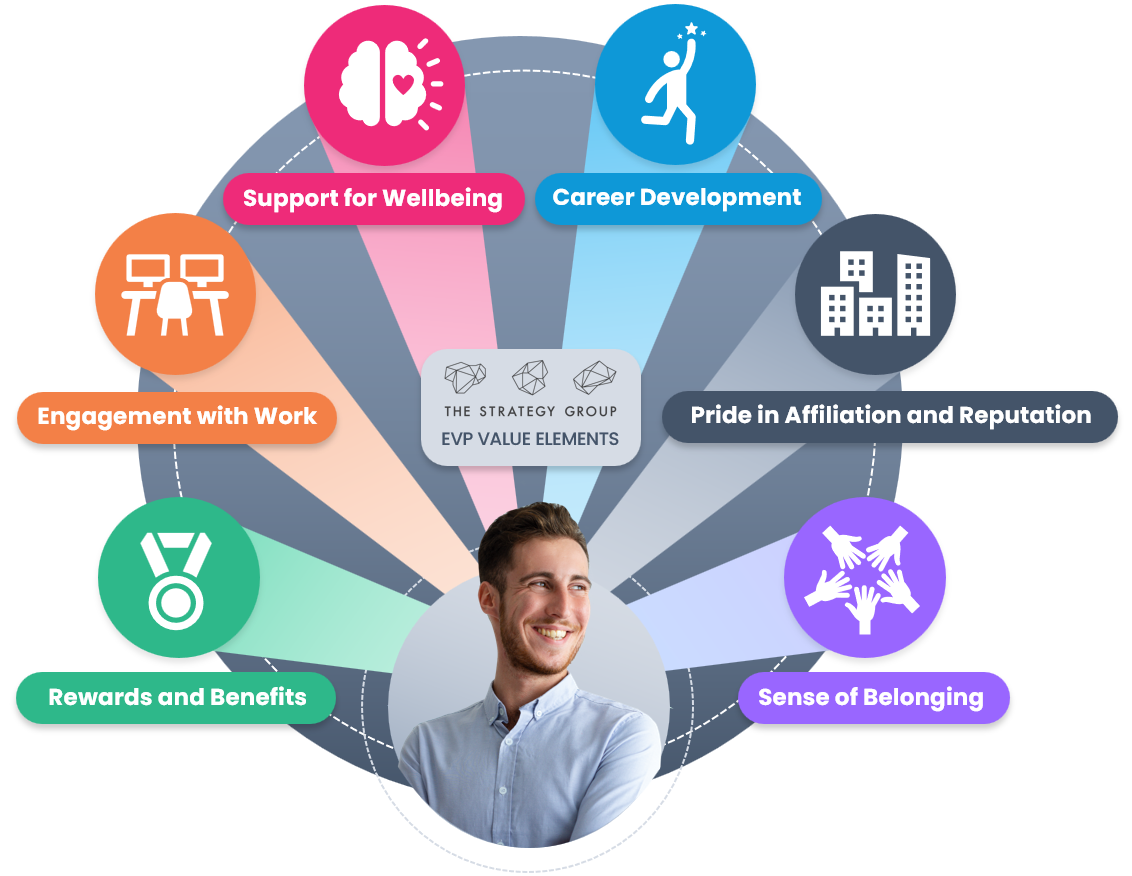EMPLOYEE VALUE PROPOSITION
EX STRATEGY
Creating clear employee value propositions that drive attraction and retention of top talent

What is an Employee Value Proposition?
An Employee Value Proposition (EVP) is a statement of the way in which an organisation creates value for their existing and future employees. The EVP includes all facets of the value an organisation provides to its employees, including both tangible elements such as remuneration and career development, and intangible elements such as culture and engagement with work.
By declaring what value the organisation will provide to its employees, and how it will do so, the EVP both sets employee expectations and provides management with a clear and accountable action plan to create a positive employee experience in their organisation. A strong and effective EVP will drive clear employee expectations and concrete actions to fulfill those expectations.
An Employee Value Proposition is a key part of an organisation’s overall employee experience strategy, which aims to retain, nurture and attract top talent.


Why Having an Employee Value Proposition is Crucial
Talent is amongst the most significant challenges for businesses in the current economic environment, with substantial headwinds when it comes to attracting and retaining talent due to three key elements:
- A tight job market with low unemployment that makes hiring more challenging
- A higher-than-usual employee turnover, in the wake of the growing ‘Great Resignation’ in the US and UK, which experts are predicting to continue to exacerbate labour retention and supply in Australia.
- Hybrid working gradually becoming the ‘standard expectation’ from employees, creating a disadvantage for organisations without such option in place
Beyond these temporal challenges, many employees are reconsidering their life choices, including where, how and who they work for, and HR departments across Australia continue to be challenged by hiring a new generation of employees, with very different work aspirations and expectations compared to elder generations.
The question which all businesses need to answer now is: How can we stand out against an increasingly tough competition to attract and retain the best talent, and sustain our growth trajectory?
A clear EVP is the answer to this question: it defines how an organisation will stand out against the competition, and thereby allows the organisation to both sell itself to prospective and current employees, and have a clear action plan of how it will improve its employee experience.
Indeed, according to Gartner, a well-crafted EVP can increase the commitment of your new hires by 50%, reduce the compensation premium that your company pays to hires by 50% and can decrease annual employee turnover by about 70%.

WHAT’S THE DIFFERENCE?
Why an EVP Cannot be an Exercise in Branding
Employee Value Propositions, poorly implemented, often become exercises in branding and communications, detached from the reality on the ground of the actual value and experience being provided to employees. This disconnect between employee expectations (set by the EVP) and the actual experience of employees working for the organisation can lead to greater disillusionment and worsened employee retention. Analogous to false advertising, which leaves customers who purchase the overhyped products dissatisfied and potentially angry, a ‘false’ EVP will have serious negative impacts on employee morale and productivity. An EVP which does not align with the actual value offered by the organisation is both redundant and counterproductive.
Thus, whilst it is essential that EVP be reflected in the employer brand and promise, this must be reinforced by clear and concrete actions to fulfill the promise, and thereby satisfy the expectations of employees.
Six Common Value Elements of an Employee Value Proposition
A convenient way for the EVP to identify and explain the value which the organisation provides to its employees is to group the value it provides under these six key elements. Within each element, the EVP should explore the unique features, initiatives and circumstances that create value for the employee. This can also be an important internal analytical tool, as organisations scan each element for areas of improvement and new initiatives which can improve their employee experience.
Six common value elements of an EVP are:

Career Development
This encompasses the ability of the organisation to provide its employees with advancement and learning opportunities, both formal and informal, that recognise and grow the ability, capacity and leadership skills of employees.

Engagement With Work
This concerns the key influences on how employees engage with their work, including their work environment and systems (tools and technologies), as well as the rewarding or gratifying nature of their work product.

Support for Wellbeing
This includes a culture of wellbeing support, flexibility of work, training staff for safety and support of other employees and other factors of supporting staff wellbeing.

Rewards and Benefits
This comprises the full range of benefits and perks provided to employees, from salary remuneration and bonuses to amenities, awards and incentives such as free gym memberships or discounts on services associated with the organisation.

Sense of Belonging
This involves a strong and inclusive organisational culture, and the methods through which the organisation drives a sense of ownership and value amongst their employees.

Pride in Affiliation and Reputation
This contains all the parts of an organisation which make employees proud and happy to be associated with the organisation, including positive reputation, social impact and alignment between employee and organisational values.
However, the key elements of organisational value will be different in every organisation. It is critical that organisations understand their unique mix of current and prospective employees, and what those employees value and feel engaged by in the organisation. In turn, they should use this information to identify their unique key elements of employee value. If an organisation attempts to apply a cookie-cutter approach to EVP, this can result in misidentifying why employees are attracted to the organisation and can flow through into ineffective attraction and retention of talent. In addition, it can result in significant waste of resources in improving elements of value that are not a priority for employees.

BUILDING YOUR EVP
4 Key Steps to Developing a Winning Employee Value Proposition
Creating a great EVP starts with your employees: understanding who they employees are and what their needs are.. This is the only way to build an EVP that will successfully attract and retain the best talent on the market. A common pitfall is to start with the needs of the business and to focus on what the business wants and expects from its employees.
Rather, the process should be an iterative one, focused on employees and reflecting the real value created for them by the organisation.
Four key steps to craft a successful and effective EVP include:

1. Identify Who You Are Designing For
When developing a winning employee value proposition (EVP), the first step is to identify who you are designing for. This means understanding the specific needs and wants of your unique group of current and prospective employees.
To identify who you are designing for, it’s important to conduct research and gather insights into the demographics, motivations, and preferences of your employees.
Once you have a clear picture of your target audience, you can then tailor your EVP to meet their needs and expectations. For example, if your employees are primarily motivated by career growth and development opportunities, your EVP might focus on highlighting the training and development programs available at your company.
In addition to understanding the needs and preferences of your employees, it’s also important to consider the competitive landscape and what other companies in your industry are offering in terms of employee benefits and perks. By understanding what sets your company apart and what makes it a great place to work, you can create an EVP that truly resonates with your employees

2. Conduct Discovery Research & Interviews
The second step in developing a winning employee value proposition (EVP) is to conduct discovery research and interviews to gather insights into the needs and preferences of your employees. This can include conducting surveys, focus groups, and one-on-one interviews with employees to gather feedback, learn more about what makes your company a great place to work.
Through this discovery process, you can gain valuable insights into the motivations, values, and preferences of your employees, whilst you should also identify any pain points or areas for improvement within your company. It is important this doesn’t devolve into a box-ticking or number rating exercise – the interviews should involve genuine engagement with the complex motivations that drive employees and the value they see in a workplace.
Once you have gathered this information, you can use it to craft a tailored EVP that resonates with your employees and addresses their specific needs and preferences. You can then iteratively test and refine your EVP through further research and interviews, ensuring that it continues to meet the evolving needs of your employees.

3. Run Co-Design Workshops to Craft Your EVP
The third step in developing a winning employee value proposition (EVP) is to run co-design workshops to craft your EVP. In these workshops, you will bring together a diverse group of employees to collaborate on the development of your EVP.
The goal of these workshops is to create an EVP that truly reflects the needs and preferences of your employees. This can be achieved through a variety of activities, such as brainstorming sessions, idea generation exercises, and feedback sessions.
During the co-design workshops, you can also incorporate the insights and feedback gathered from the discovery research and interviews conducted in the previous step. This will ensure that your EVP is informed by the voices and perspectives of your employees, making it more likely to resonate with them.
In addition to creating your EVP, these workshops should also be used to validate your EVP by gathering feedback from employees and making any necessary revisions. This will ensure that your EVP is well-received and effective in attracting and retaining top talent.

4. Develop Employee Opportunities and Plan to Deliver on your EVP
The fourth and final step in developing a winning employee value proposition (EVP) is to develop employee opportunities and create a plan to deliver on your EVP. This involves identifying specific actions and initiatives that you can implement to make your EVP a reality for your employees.
Having gained valuable insights from discovery research, interviews, and co-design workshops, you can now develop a range of opportunities to improve your organization’s EVP. These opportunities should be assessed and prioritized, with clear accountabilities across the business, to ensure that they are implemented effectively and in a timely manner.
For example, you may have identified a need for more training and development opportunities, or for a stronger focus on work-life balance. To address these needs, you could develop training programs, create flexible work arrangements, and implement additional time off policies.
Once you have identified the specific actions and initiatives that you will take to deliver on your EVP, you should create a plan for how you will communicate and promote your EVP to both potential and current employees. This can include creating marketing materials, such as brochures and videos, and hosting events and information sessions to showcase the benefits and opportunities available at your company.
The development of employee opportunities and a plan to deliver on your EVP is crucial for ensuring that your EVP is more than just words on paper, but is actually implemented and experienced by your employees.


EMPLOYEE VALUE PROPOSITION EXAMPLE
Employee Value Proposition Case Study: Creating an EVP for a Large NSW Council
We have recently assisted a large council in NSW in developing their unique Employee Value Proposition.
The Challenge
The Council faced significant challenges in retaining and attracting top talent, as well as in growing and utilising that talent. This was set against a backdrop of the Council requiring a growing, talented and agile workforce to provide services to a rapidly growing population.
To solve these significant challenges, the Council needed to identify its unique Employee Value Proposition, and in turn develop an actionable EVP framework which provided clear short and long-term opportunities to improve the EVP of the council.
The Process
The Strategy Group co-designed an Employee Value Proposition through extensive research and a series of workshops and interviews with employees and management. We employed an iterative process, validating the EVP framework through further workshops with employees, where we ensured that the EVP framework accurately reflected the reality of the business, and the needs and wants of employees.
Through this process, we identified and refined the key elements of value that the Council provided to its employees. Critically, we put the employees in the centre and built the EVP around their wants and needs, rather than just those of management, conducting a gap analysis to identify the difference between the importance that employees placed on each element and their satisfaction with the value provided by the element.
We emphasised that an effective Employee Value Proposition demands action, analysing the insights from interviews, workshops and research to create clear and effective opportunities for the council to implement to improve each key element of employee value in both the short-term and the long-term.
The Outcome
The Council emerged with a robust EVP Framework and a clearly-defined path ahead with the opportunities to be able to attract and retain employees whilst offering an enriching experience that exceeds their expectations and makes them feel special.
Why The Strategy Group should be your strategy partner
We will work with you to design and support implementation of a strategy for your business unit, for your entire organisation, or for any segment of your organisation where a fresh approach will add value.
We will use a combination of globally-recognised leading-edge processes, coupled with our proprietary validated toolbox to develop a bespoke, customised strategy, which we can assist you in implementing, that will deliver tangible impact and value to your organisation, employees and customers.
We have been designing and implementing strategy solutions since 2003 and we have the expertise and the experience not only to deliver, but to overdeliver.





